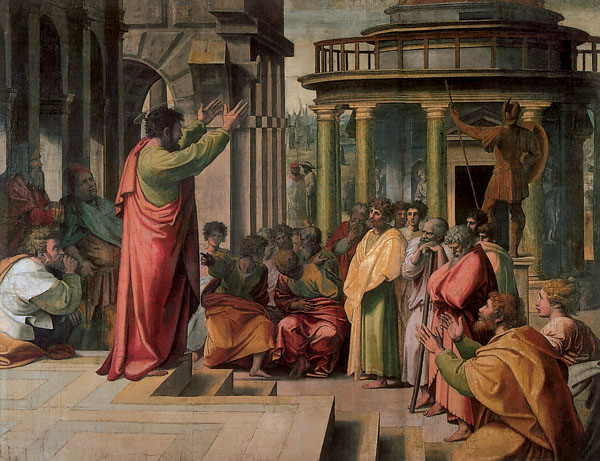Raphael, Saint Paul Preaching in Athens,
cartoon from the Life of Paul, 1515-1516.
Gouache and charcoal on paper, mounted on canvas,
343 x 442 cm. Victoria and Albert Museum, London.
In the 4th century, however, Justinian took measures to emancipate the empire from such an onerous burden. Learning that two monks had travelled in China and discovered the secret of the treatment of silkworms, he ordered them to return and retrieve the eggs necessary to attempt their acclimatisation. The envoys, with pains and perseverance, succeeded in their undertaking. They concealed some eggs in the hollow tube of bamboo canes and kept warm by laying them on small beds of manure; once hatched, they fed the young worms with wild mulberry leaves. Thus, after enduring countless hardships, they finally reached Constantinople and were privileged to endow Europe with the first elements of one of its choicest industries.
The breeding of silkworms succeeded very well in Constantinople, Syria, Greece, and especially in the Peloponnesus. But in the war against Greece, undertaken by Robert Guiscard, Roger of Sicily, having made himself master of this country, is said to have brought away Theban and Corinthian artisans, employed in the weaving of costly fabrics enriched with gold, as captives. He settled them in Palermo, capital of Sicily, and ordered them to instruct his subjects in their art. It was thus, says Othon of Friesingen, that this industry finally ceased to be a mystery for the Latin races. This generally accepted opinion, however, is questioned by several writers, and especially by Sig. Amari.
If the Greek workmen were not really brought to Sicily until 1146, they must have found the silk industry already regularly established in Palermo. A proof of this is inscribed on the magnificent cloak still preserved in the Museum of Vienna. The silken fabric is divided into two segments by an ornamental palm tree laden with fruit. At the base are two groups each composed of a lion with his head thrown back fiercely, falling upon a camel. Around the border, in ancient Arabic Kufi, runs this inscription:
(This cloak) forms part of what was made in the royal manufactory where reign happiness, honour, prosperity, success, merit, and distinction, which can rejoice in a great aggrandisement and a glorious prosperity, great liberality, and great splendour, glory and splendid endowments, as well as the fulfilment of hopes and desires; where the nights and the days ought to flow in pleasure without end or change, with the sentiment of honour, devotion, and participation in happiness and the preservation of prosperity, of support, and of suitable industry (in the capital of Sicily the year 528 of the Hegira).
This date, the equivalent of 1133 CE, coincides with the middle of the reign of Roger II and the inscription speaks clearly of a “prosperous and enlarged” factory, not by Greek hands, but by Arabs. This would be sufficiently evident from the Arab-Sassanian style of the ornaments even if it were not expressly stated, and we did not otherwise know that in imitation of the Umayyad caliphs, the Muslim dynasties of the East or the West had a workshop in the royal palace, called the Tiraz, strictly for the manufacture of silk destined for weaving the robes of eminent persons. The Norman kings of Sicily followed this example by employing Arab workers, and, if we are to believe Arab author Ebn Djobaïr, silk manufacturing was but a convenient name for disguising the seraglio, where they had taken a fancy to introducing young French women.
